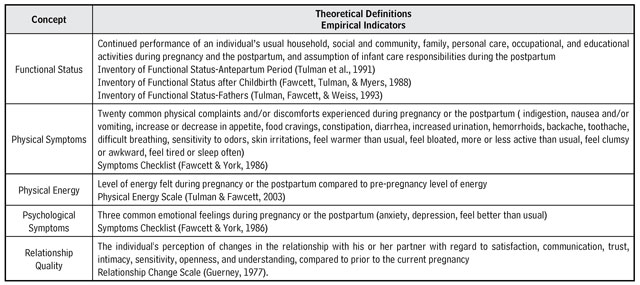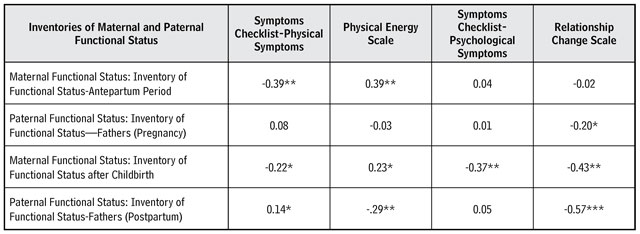The purpose of this paper is to present a preliminary situation-specific theory that is based on the findings of a pilot study of correlates of maternal and paternal functional status during high-risk pregnancy and the postpartum 1, and to discuss how the theory could be tested and used in nursing practice. The pilot study and derivation of the theory were guided by Roy's Adaptation Model (RAM) 2.
A pilot study typically includes a relatively small number of participants and is conducted to determine whether a study with a larger number of participants would be feasible. Determination of feasibility includes the appropriateness of the research design, the adequacy of the procedures used to recruit and retain participants and to collect and analyze the data, the appropriateness of the empirical indicators (research instruments), and effect sizes 3,4. Effect size refers to the magnitude of the association between empirical indicators for concepts, rather than statistical significance 5.
A situation-specific theory is defined as a set of concepts and statements about the concepts that address a specific population and a specific health condition 6. The statements about the concepts include their theoretical and operational definitions, and the links between the concepts. Definitions are the non-relational propositions of a theory, whereas statements of linkages are the relational propositions 3. Our preliminary situation-specific theory focuses on a population of expectant and new mothers and fathers experiencing high-risk childbearing.
The pilot study was the next step in a program of research addressing functional status during low-risk childbearing, which began 30 years ago with women from Mid-Atlantic states 7-9 The pilot study was approved by university and hospital institutional review boards and all participants gave written or oral informed consent. Each study participant was compensated $10 for time spent on data collection. The participants, who resided in either a New England or a Southern state of the United States of America, were recruited from hospital clinics and a private physician's office. The typical study participant was 31 years of age; white, non-Hispanic; had at least a high school education; and was employed outside the home or was on maternity or paternity leave. Data were collected in person or by telephone. Descriptive statistics (means, standard deviations, ranges) indicated that maternal functional status was relatively high during pregnancy, whereas paternal functional status was moderate at that time.
Both maternal and paternal functional status was moderate during the postpartum.
The Preliminary Situation-Specific Theory: Adaptation to High-Risk Childbearing
The conceptual-theoretical-empirical structure for the pilot study is depicted in the Figure. As can be seen in the Figure, the RAM adaptive system was represented by expectant and new mothers and fathers; the samples from the pilot study were the empirical indicators. The focal stimulus was represented by high-risk pregnancy, as documented by a healthcare provider. Contextual stimuli were represented by demographic variables, recorded on the Background Data Sheet; these data were used to describe the characteristics of the samples.
The five concepts of the situation-specific theory of adaptation to high-risk childbearing were linked to the RAM adaptive modes. Functional status, measured by Inventories of Functional Status 10-12, represented the RAM role function mode. Physical symptoms, measured by the Symptoms Checklist 13, and physical energy, measured by the Physical Energy Scale 8, represented the RAM physiological mode. Psychological symptoms, measured by the Symptoms Checklist 13, represented the RAM self-concept; relationship quality, measured by the Relationship Change Scale 14, represented the RAM interdependence mode. (See the Figure). The theoretical definition for each concept and the way in which each concept was measured are given in Table 1.

Source: Own elaboration.
Figure 1. Conceptual-Theoretical-Empirical Structure for a Pilot Study of Correlates of Maternal and Paternal Functional Status during High-Risk Pregnancy and the Post-Partum.
Table 1 Definitions of the Concepts of the Theory of Adaptation to High-Risk Pregnancy

Source: Own elaboration.
The relational propositions for the situation-specific theory are based on the RAM proposition that responses in one adaptive mode are associated with responses in other adaptive modes 2. For the purposes of development of the situation-specific theory of adaptation to high-risk childbearing, the relations of the physiological, self-concept, and interdependence modes to the role function mode are relevant. The relational propositions of the theory, which are listed below, were determined by an examination of the magnitude of the correlations of the empirical indicators for the theory concepts representing the modes of adaptation. The correlations seen in Table 2 are interpreted as effect sizes; statistical significance was not relevant due to the small sample sizes 5. Correlations below 0.10 are too small to be considered as meaningful relations and, therefore, are not included as relational propositions for the theory.
Table 2 Effect Sizes (Spearman's Rho Correlation Coefficients) for Correlates of Maternal and Paternal Functional Status during Pregnancy and the Postpartum

*Small effect sizes (rho = .10) are considered relations of low magnitude; **Medium effect sizes (rho = .30) are considered relations of moderate magnitude; ***Large effect sizes (rho = .50) are considered relations of large magnitude.
Source: Own elaboration
During pregnancy, for expectant mothers:
There is a negative relation of moderate magnitude between physical symptoms and maternal functional status; so, the greater the number of physical symptoms, the lower the maternal functional status.
There is a positive relation of moderate magnitude between physical energy and maternal functional status; so, the greater the level of physical energy, the higher the maternal functional status
During pregnancy, for expectant fathers:
There is a negative relation of low magnitude between relationship quality and paternal functional status; so, the less the change in relationship quality, the greater the paternal functional status
During the postpartum, for new mothers:
There is a negative relation of low magnitude between physical symptoms and maternal functional status; so, the greater the number of physical symptoms, the lower the maternal functional status.
There is a positive relation of low magnitude between physical energy and maternal functional status; so, the greater the level of physical energy, the higher the maternal functional status
There is a negative relation between psychological symptoms and maternal functional status; so, the greater the number of psychological symptoms, the lower the maternal functional status.
There is a negative relation of moderate magnitude between relationship quality and maternal functional status; so, the less the change in relationship quality, the greater the maternal functional status.
During the postpartum, for new fathers:
There is a positive relation of low magnitude between physical symptoms and paternal functional status; so, the greater the number of physical symptoms, the higher the paternal functional status
There is a negative relation approaching moderate magnitude between physical energy and paternal functional status; so, the greater the physical energy, the lower the paternal functional status
There is a negative relation of large magnitude between relationship quality and paternal functional status; so, the less the change in relationship quality, the greater the paternal functional status.
Discussion
As can be seen in Table 2, the correlations on which the relational propositions are based revealed that correlates of maternal functional status differ from correlates of paternal function status, These correlations also revealed that physical symptoms and physical energy during pregnancy have relations with maternal functional status of stronger magnitude than did these concepts during the postpartum; that is, effect sizes were larger during pregnancy than during the postpartum. In addition, the correlations revealed that relationship quality had the greatest influence on both maternal and paternal functional status postpartum than any other concept; that is, the largest effect sizes were for relationship quality for both parents during the postpartum.
Implications for Nursing Research and Nursing Practice
The situation-specific theory of adaptation to high-risk pregnancy is at a preliminary stage of development. Future research should focus on determining the empirical adequacy of the theory by testing each of the relational propositions to determine whether the effect sizes are stable with larger samples. Ideally, a longitudinal study should be conducted to follow expectant parents from early in pregnancy through at least six months postpartum.
Although it is tempting to recommend how the theory could be used in practice at this time, it is important to wait until research findings indicate whether the theory is empirically adequate. However, a test of the theory could be conducted in the "real world" of clinical nursing practice, rather than in a "formal" research project. The benefit of this approach would be that a nurse researcher from a university could form a partnership with one or more nurses who are in the "real world" of practice to test the theory propositions, as well as to determine the feasibility of implementing the theory in practice.














